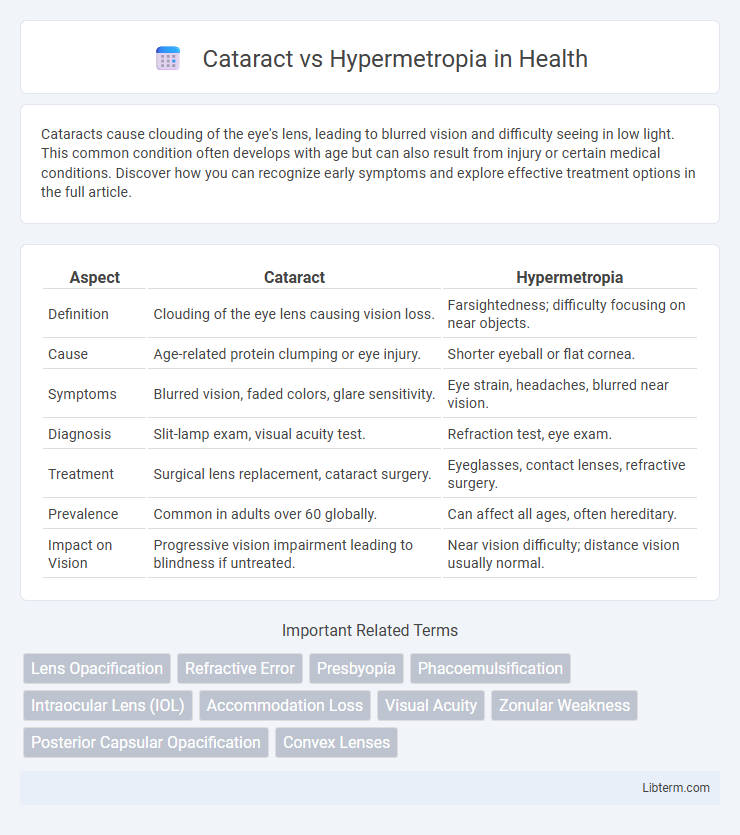Cataracts cause clouding of the eye's lens, leading to blurred vision and difficulty seeing in low light. This common condition often develops with age but can also result from injury or certain medical conditions. Discover how you can recognize early symptoms and explore effective treatment options in the full article.
Table of Comparison
| Aspect | Cataract | Hypermetropia |
|---|---|---|
| Definition | Clouding of the eye lens causing vision loss. | Farsightedness; difficulty focusing on near objects. |
| Cause | Age-related protein clumping or eye injury. | Shorter eyeball or flat cornea. |
| Symptoms | Blurred vision, faded colors, glare sensitivity. | Eye strain, headaches, blurred near vision. |
| Diagnosis | Slit-lamp exam, visual acuity test. | Refraction test, eye exam. |
| Treatment | Surgical lens replacement, cataract surgery. | Eyeglasses, contact lenses, refractive surgery. |
| Prevalence | Common in adults over 60 globally. | Can affect all ages, often hereditary. |
| Impact on Vision | Progressive vision impairment leading to blindness if untreated. | Near vision difficulty; distance vision usually normal. |
Introduction to Cataract and Hypermetropia
Cataract is a condition characterized by the clouding of the eye's natural lens, leading to diminished vision and increased glare sensitivity. Hypermetropia, or farsightedness, is a refractive error where distant objects are seen more clearly than close ones due to the eyeball being too short or the cornea having insufficient curvature. Both conditions impact visual acuity but stem from distinct anatomical and physiological causes within the eye.
Defining Cataract: Causes and Symptoms
Cataract is a clouding of the eye's natural lens, leading to blurred vision and potential blindness if untreated. Common causes include aging, prolonged UV exposure, diabetes, smoking, and eye injuries. Symptoms often involve faded colors, glare sensitivity, difficulty seeing at night, and double vision in one eye.
Understanding Hypermetropia: Causes and Symptoms
Hypermetropia, also known as farsightedness, occurs when the eyeball is too short or the cornea has insufficient curvature, causing light to focus behind the retina. Common symptoms include blurred vision for close objects, eye strain, headaches, and difficulty concentrating on near tasks. Unlike cataract, which involves clouding of the eye's lens, hypermetropia primarily affects the eye's focusing ability without lens opacity.
Key Differences Between Cataract and Hypermetropia
Cataract is a condition characterized by clouding of the eye's natural lens leading to blurred vision, while hypermetropia, or farsightedness, results from the eyeball being too short or the cornea having insufficient curvature, causing difficulty focusing on close objects. Cataracts primarily affect older adults due to lens protein degeneration, whereas hypermetropia is often hereditary and can appear at any age. Treatment for cataracts typically involves surgical removal of the cloudy lens, whereas hypermetropia is corrected using convex lenses or refractive surgery.
Risk Factors for Cataract and Hypermetropia
Cataract risk factors include advanced age, prolonged ultraviolet (UV) exposure, diabetes mellitus, smoking, and steroid use, all contributing to lens opacity and impaired vision. Hypermetropia, or farsightedness, primarily results from an abnormally short eyeball or a flattened cornea, with genetic predisposition and age-related changes influencing its development. Understanding these distinct risk factors aids in early detection and targeted management to reduce visual impairment.
Diagnosis: How Cataract and Hypermetropia Are Detected
Cataract is diagnosed through a comprehensive eye examination using a slit lamp to detect clouding of the lens, along with visual acuity tests to assess vision impairment. Hypermetropia, or farsightedness, is identified via a refraction test using a phoropter or autorefractor, measuring the eye's focusing ability and determining the need for corrective lenses. Both conditions require precise diagnostic techniques to differentiate lens opacity from refractive errors for effective treatment planning.
Treatment Options for Cataract
Cataract treatment primarily involves surgical removal of the cloudy lens, followed by implantation of an artificial intraocular lens (IOL) to restore vision. Non-surgical options do not reverse cataracts but may include stronger prescription glasses or magnifying lenses for temporary vision improvement. Hypermetropia, or farsightedness, differs as it is commonly managed with corrective lenses or refractive surgery, not lens replacement.
Treatment Options for Hypermetropia
Hypermetropia, or farsightedness, is commonly treated with corrective lenses such as eyeglasses or contact lenses that adjust the focus of light onto the retina. Refractive surgeries like LASIK or PRK offer permanent solutions by reshaping the cornea to improve near vision. Unlike cataract treatment, which often involves surgical removal of the clouded lens followed by intraocular lens implantation, hypermetropia management primarily centers on optical correction and corneal surgical options.
Prevention and Management Strategies
Cataract prevention involves protecting eyes from UV radiation, maintaining a healthy diet rich in antioxidants, and managing chronic conditions like diabetes to slow lens opacity progression. Hypermetropia can be managed with corrective lenses such as glasses or contact lenses, and preventive strategies include regular eye exams to detect refractive changes early and ergonomic practices to reduce digital eye strain. Surgical options like cataract extraction and LASIK for hypermetropia offer effective long-term management when conservative measures are insufficient.
Outlook: Quality of Life with Cataract vs Hypermetropia
Cataract significantly impairs vision by clouding the eye's lens, often leading to decreased quality of life through reduced visual acuity, difficulty with daily activities, and increased risk of falls, though surgery typically restores clear vision effectively. Hypermetropia, or farsightedness, causes blurred near vision but is generally managed well with corrective lenses or refractive surgery, maintaining a stable quality of life without progressive vision loss. Overall, untreated cataracts pose a greater threat to long-term vision and daily functioning compared to hypermetropia, emphasizing the critical role of timely cataract intervention.
Cataract Infographic

 libterm.com
libterm.com